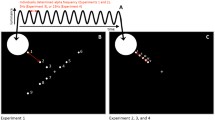Abstract
The depth profile of the electroretinographic oscillatory potentials was studied in the isolated frog retina. The intraretinal electrode was introduced from the receptor side, and the reference electrode was placed on the vitreal side. The electroretinogram, recorded either transretinally or with the electrode tip in the receptor layer, showed 4 to 10 oscillatory potential wavelets. As the electrode was advanced proximally, the wavelets disappeared as a function of retinal depth. The wavelets with longer peak latencies disappeared earlier, and only the first one or two wavelets could be identified when the electrode was in the inner plexiform layer. These findings indicate that the oscillatory potentials are generated between the inner and outer plexiform layers and that the earlier wavelets originate in the more proximal retina. The results are consistent with the notion that the oscillatory potentials are generated by synaptic feedback circuits.
Similar content being viewed by others
References
Brindley GS, Hamasaki DI. The properties and nature of the R-membrane of the frog's eye. J Physiol (Lond) 1963; 167: 599–606.
Brown KT. The electroretinogram. Its components and their origins. Vision Res 1968; 8: 633–677.
Burkhardt DA. Proximal negative response of frog retina. J Neurophysiol 1970; 33: 405–420.
Dowling JE, Ehinger B, Hedden WL. The interplexiform cell: A new type of retinal neuron. Invest Ophthalmol 1976; 15: 906–926.
Fujimoto M, Tomita T. Relationship between the electroretinogram (ERG) and the proximal negative responses (PNR). Jpn J Physiol 1980; 30: 377–392.
Heynen H, Wachtmeister L, van Norren D. Origin of the oscillatory potentials in the primate retina. Vision Res 1985; 25: 1365–1373.
Kawaguchi H, Yonemura D, Kawasaki K, Yanagida T. Selective suppression of retinal oscillatory potential by some ω-amino acids and its release by their antagonists in human and rabbit in vitro. Acta Soc Ophthalmol Jpn 1980; 84: 135–141.
Kawasaki K, Yonemura D. Effects of polarizing current on the ERG (III). Acta Soc Ophthalmol Jpn 1972; 76: 71–73.
Korol S, Leuenberger PM, Englert U, Babel J. In vivo effects of glycine on retinal ultrastructure and averaged electroretinogram. Brain Res 1975; 97: 235–251.
Tomita T. The electroretinogram, as analyzed by microelectrode studies. In: Handbook of Sensory Physiology, Vol 7, Part 2, Heidelberg: Springer-Verlag, 1972; 635–662.
Tomita T, Murakami M, Hashimoto Y. On the R-membrane in the frog's eye: Its localization and relation to the retinal action potential. J Gen Physiol 1960; 43: 81–94.
Wachtmeister L. The action of peptides on the mudpuppy electroretinogram (ERG). Exp Eye Res 1983; 33: 429–437.
Wachtmeister L, Dowling JE. The oscillatory potentials of the mudpuppy retina. Invest Ophthalmol Vis Sci 1978; 17: 1176–1188.
Yanagida T. Studies on the origin of the electroretinographic (ERG) b-wave by intraretinal K injection into the frog retina. Acta Soc Ophthalmol Jpn 1983; 87: 289–299.
Yanagida T, Koshimizu M, Kawasaki K, Yonemura D. Microelectrode depth study of the electroretinographic b- and d-waves in the frog retina. Jpn J Ophthalmol 1986; 30: 298–305.
Yanagida T, Tomita T. Local potassium concentration changes in the retina and the electroretinographic (ERG) b-wave. Brain Res 1982; 237: 479–483.
Yonemura D, Aoki T, Tsuzuki K. Electroretinogram in diabetic retinopathy. Arch Ophthalmol 1962; 68: 19–24.
Yonemura D, Hatta M. Studies of the minor components of the frog's electroretinogram. Jpn J Physiol 1966; 16: 11–22.
Yonemura D, Kawasaki K. New approaches to ophthalmic electrodiagnosis by retinal oscillatory potential, drug-induced response from retinal pigment epithelium and cone potential. Doc Ophthalmol 1979; 48: 163–222.
Yonemura D, Kawasaki K, Yanagida T, Tanabe J, Kawaguchi H, Nakata Y. Effects of Ω-amino acids on oscillatory activities of the light-evoked potentials in the retina and visual pathways. Proc 16th ISCEV Symposium, Morioka, 1979; 339–353.
Author information
Authors and Affiliations
Rights and permissions
About this article
Cite this article
Yanagida, T., Koshimizu, M., Kawasaki, K. et al. Microelectrode depth study of the electroretinographic oscillatory potentials in the frog retina. Doc Ophthalmol 67, 355–361 (1987). https://doi.org/10.1007/BF00143953
Issue Date:
DOI: https://doi.org/10.1007/BF00143953




